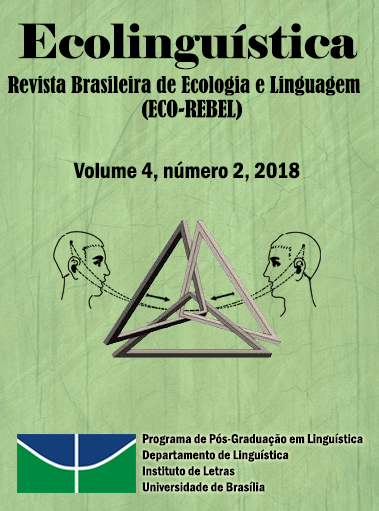Quando gafanhoto significa relâmpago
como o conhecimento ecológico é codificado nas línguas ameaçadas
Palavras-chave:
Diversidade biocultural; línguas ameaçadas; léxico mental; narrativa; conhecimento ecológico tradicional.Resumo
In response to world-wide extinction of both indigenous languages and endemic species, an international, interdisciplinary movement has arisen with the goal of conserving biocultural diversity. The fundamental insight of biocultural conservation initiatives is that established correlations between cultural diversity and biodiversity (and endangerment) may point to solutions to the present crisis. This paper highlights one understudied aspect of this endeavor ”“ how ecological knowledge is encoded in endangered languages ”“ before considering how linguists may contribute to this growing community of practice. The most obvious linguistic encoding of traditional ecological knowledge is in the mental lexicon: words that refer to objects, events, and states in the natural world, as shown in examples drawn from languages such as Kayapó, Piaroa, and Minangkabau. Equally important for the linguistic transmission of ecological knowledge are the narratives found in stories, myths and ceremonial recitation, as exemplified by Chehalis, Wayampi, and Bininj Gunwok. Linguists who join this interdisciplinary struggle for environmental conservation and social justice may contribute not only through primary fieldwork, linguistic analysis, or expertise in multilingual education programs, but also by raising consciousness of the beauty and value of biocultural diversity through social outreach.
Downloads
Downloads
Publicado
Como Citar
Edição
Seção
Licença
Autores que publicam nesta revista concordam com os seguintes termos:
Autores mantêm os direitos autorais e concedem à revista o direito de primeira publicação, sendo o trabalho simultaneamente licenciado sob a Creative Commons Attribution License o que permite o compartilhamento do trabalho com reconhecimento da autoria do trabalho e publicação inicial nesta revista.
Autores têm autorização para assumir contratos adicionais separadamente, para distribuição não exclusiva da versão do trabalho publicada nesta revista (ex.: publicar em repositório institucional ou como capítulo de livro), com reconhecimento de autoria e publicação inicial nesta revista.
Autores têm permissão e são estimulados a publicar e distribuir seu trabalho online (ex.: em repositórios institucionais ou na sua página pessoal) a qualquer ponto antes ou durante o processo editorial, já que isso pode gerar alterações produtivas, bem como aumentar o impacto e a citação do trabalho publicado (Veja O Efeito do Acesso Livre).



3.png)



